‘One Piece’ Director Marc Jobst Talks Adapting the Best-Selling Manga and His ‘Daredevil’ Memories
- Oops!Something went wrong.Please try again later.
- Oops!Something went wrong.Please try again later.
- Oops!Something went wrong.Please try again later.

From Daredevil and Luke Cage to The Witcher and now One Piece, Marc Jobst has quietly become one of Netflix’s most prolific directors.
Born in Zimbabwe, the One Piece director/executive producer has now worked on seven Netflix series, and he has Luke Cage to thank in particular for this latest collaboration. In 2018, Jobst directed Cage’s season two episode, “Wig Out,” which was written by Matt Owens, One Piece’s co-showrunner. Owens never forgot the way Jobst handled the varying tones of his Cage episode, so that encounter led to Jobst directing the first two episodes of One Piece and setting the tone for the entire series, which released on Thursday.
More from The Hollywood Reporter
Venice: Caleb Landry Jones, Luc Besson Talk Casting 70 Canines for 'Dogman'
Venice: Adam Driver Talks 'Ferrari,' Calls Out Netflix and Amazon Amid Strikes
“Out of the blue, I got this phone call asking if I would be interested in coming to talk about shooting One Piece. And what Matt [Owens] told me was, it was partly because of the fact that I leant into some of that warmth and that humor [in his Luke Cage episode] that made him think of me for One Piece,” Jobst tells The Hollywood Reporter.
Netflix’s live-action One Piece series is based on Eiichiro Oda’s best-selling manga of all time, and the faithful adaptation has already received the Japanese artist’s blessing. The fantasy adventure was first adapted into a Japanese anime series in 1999 and now boasts over 1,000 episodes, as well as numerous animated films and TV specials in Japan.
The new series chronicles the adventures of Monkey D. Luffy (Iñaki Godoy) and the Straw Hat Pirates, as they pursue the long-lost treasure known as the One Piece. With a series filled with such specificity, casting became all the more important for Jobst, and so the process involved a worldwide search that lasted nearly a year.
“In world-building shows, it is really easy to spend all your time and money on that. But to me, an audience doesn’t fall in love with a set or a location. They fall in love with people,” Jobst says. “So if you can get that right, and you can get actors to play characters that the audience cares about and believes are authentic and real and grounded and human, then you’ve got them forever.”
Below, during a conversation with THR, Jobst also discusses his unforgettable experiences on the sets of Daredevil and Luke Cage, and whether returning characters like Daredevil (Charlie Cox), Kingpin (Vincent D’Onofrio) and the Punisher (Jon Bernthal) will translate within the more accessible tone of the MCU proper.
So does Netflix have you on speed dial at this point? I think the count is up to seven series.
(Laughs.) Is it really? Oh my God, I wish they did. I don’t know that they have anybody on speed dial, but we have a great relationship. The film business is built on trust, isn’t it? The more you work together and the more you realize that you can do good work together, the more you want to work with those kinds of people. And when you trust people, you afford them greater risks. And for me to come in to do something like One Piece, you have to take some risks. You have to be bold. You have to dare. And when you’re working with a team of people who trust you in the risk taking that you do, that’s worth a lot.
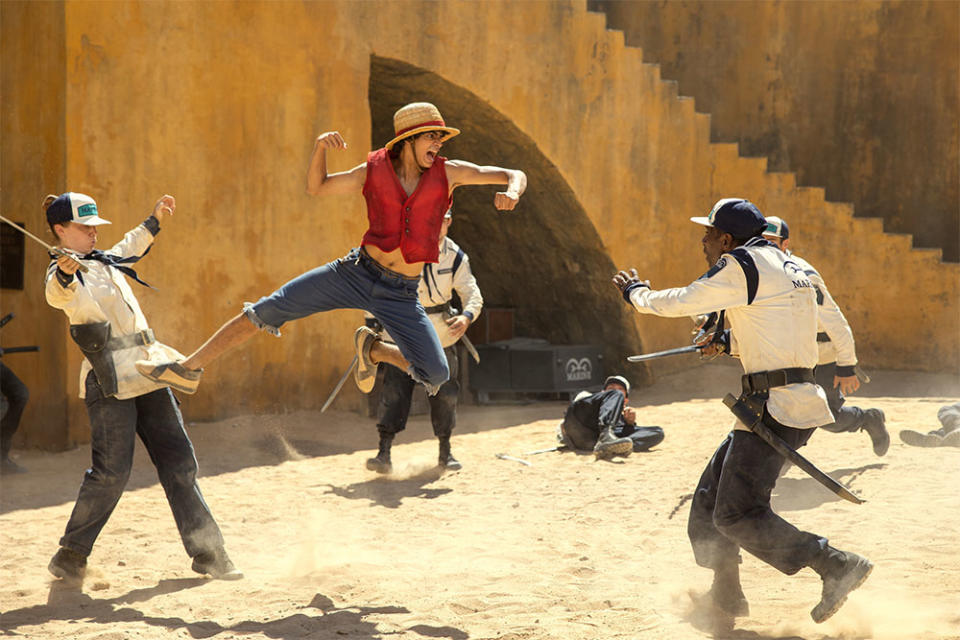
Was there someone in common from a past Netflix project?
Matt Owens, who’s the co-showrunner. I shot an episode of his for Luke Cage, and it was a really lovely episode. It had all the trademark Luke Cage action sequences, but he always had a lovely twist of humor and warmth to his writing, and I really enjoyed that. So I dived into it when I shot that episode, and I just loved working with Matt. And then out of the blue, I got this phone call asking if I would be interested in coming to talk to them about shooting One Piece. And what Matt told me was it was partly because of the fact that I leant into some of that warmth and that humor [in his Luke Cage episode] that made him think of me for One Piece.
Admittedly, I didn’t know what to expect because I haven’t devoted enough of my time to anime and manga, but I really enjoyed One Piece. How familiar were you with these mediums going into One Piece?
Well, I knew of One Piece‘s existence. I knew of the anime as well, but I didn’t know it at all. So the first I knew about it was when the studio phoned me up and said, “Would I be interested in chatting to them about it?” So I said, “Well, can I read the scripts?” And then I read Steven [Maeda] and Matt’s scripts, which I thought were epic and huge and world-building and quirky and crazy and full of action and adventure. They also had real intimacy and real insight into character and our world, and I felt that was really unusual. You don’t often get that intimacy with big world-building epic shows. And it was sunny. It was optimistic. It had hope to it. It was blue skies and high seas. It was about being free. It was about believing in your dreams and believing in who you are and becoming more of who you are. So I felt that the world needed some stories like this, and I wanted to be part of it.
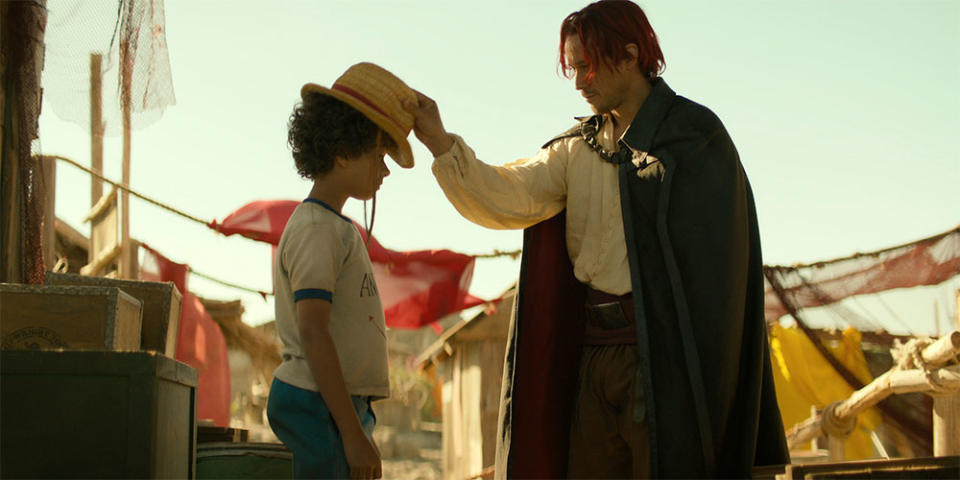
There’s a whimsy to the show that I appreciate, but it doesn’t come at the expense of emotion, such as the Luffy-Shanks backstory. How tricky was it to find that tone?
You put your finger right on the button there. It’s all about tone. Steve, Matt, the studio, Netflix and I talked a lot about tone when we were working. If you make it too whimsical and too quirky, then it just becomes a bit silly and unbelievable. If you lean too much into the darkness of it — and there is some darkness — then you lose what is One Piece. Somehow, you have to find that balance. Steve and Matt had written these beautiful scripts that I felt had really found that balance, and for me as a director coming into it, my job was to honor that in the script and then build on it. Part of that was about how we cast it. Part of that was how we shot the action, because I didn’t want it to be like the Marvel action that I’d shot or The Witcher action that I’d shot. And part of it was just about how we used the camera to find a style and a camera language that would somehow evoke that tone and the manga framings. So those three pillars were incredibly important: The casting, the action and then how you frame it and shoot it.
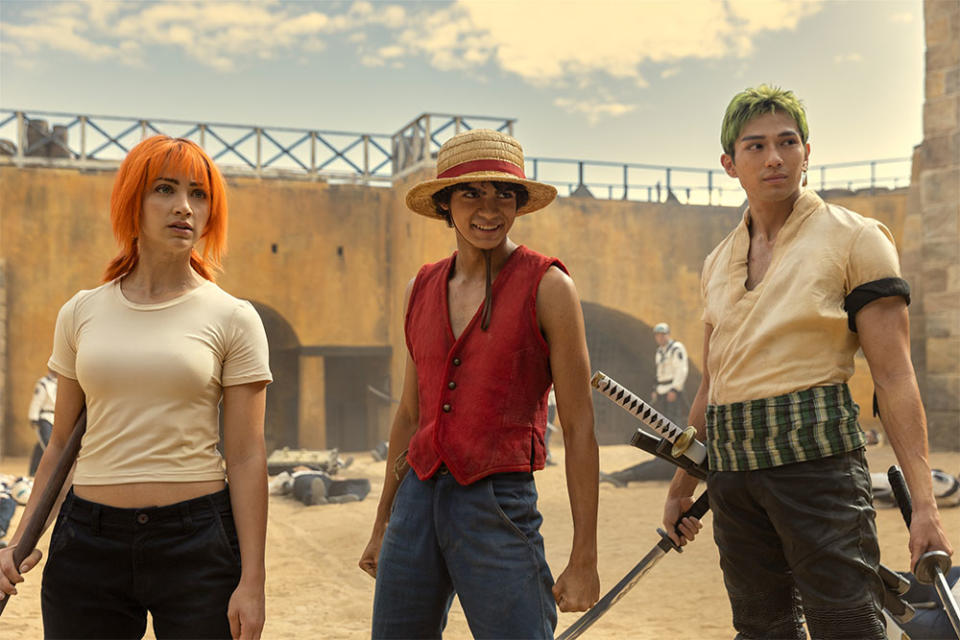
These characters are quite specific, so was casting next to impossible?
(Laughs.) Yeah, but I love that. I come from theater, and the actor is everything to me as far as I’m concerned. You can have all the whizbangs and fantastic sets and visual effects, but if you haven’t got a fantastic performance in your frame, who cares? So I love actors, I love working with actors, and I love casting actors. We all knew this show was going to stand or fall on whether we could find the right ones. So there were nine months of casting all over the world. We saw hundreds of people, and we were looking for something really specific. We wanted actors who had heart, and who had depth and humor.
And on top of that, because of how I like to shoot action and how I particularly wanted to shoot action for One Piece, I wanted actors who could not only act but could also be physical. I wanted actors who could be fit and strong and carry a choreography, so that I could shoot the action as fluidly as I wanted to be able to do it. That’s a big ask. But the thing is, in world-building shows, it is really easy to spend all your time and money on the world building of it. But to me, an audience doesn’t fall in love with a set or a location. They fall in love with people. So if you can get that right and you can get actors to play characters that the audience cares about and believes are authentic and real and grounded and human, then you’ve got them forever. They’ll care about what happens to them, and what their dilemmas are and what their relationships are.
One of the selling points of this series is that you honored the source material, but was there anything that proved to be unadaptable?
Great question, but no. It was really about making the transition from two-dimensional drawings on a piece of paper in which your characters are boundaryless to warm-blooded three-dimensional human beings who are boundaried by their own body. So there are certain things that you can see in the manga that the human body just can’t do. Now you could do it with CGI, but you have to believe it. You have to bring your audience with you. And one of the things that we all agreed on, as evidenced by Steve and Matt’s scripts, is that we had to dimensionalize the characters. We had to give them a full emotional life with a backstory that we cared about. We had to know what they wanted and where they were trying to get to. So we had to give the audience a story that they can recognize and relate to.
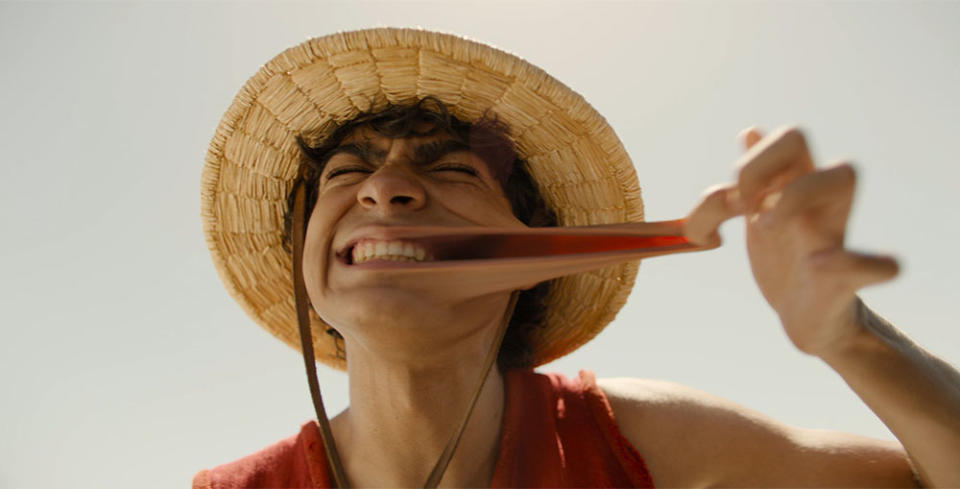
There is a great deal of VFX on this show, namely Luffy’s elasticity. Are you glad you did some VFX-heavy shows like The Witcher and Jupiter’s Legacy before doing this?
Yes, and all the others like the Marvel shows and Hannibal. One Piece is not a show for a rookie director. It’s the most complicated show I’ve ever done, and you need to learn how much you can do in-camera and what you can’t do in-camera. So you have to have a proper dialogue with your visual effects team, and I worked with these people before on The Runaways. Because, in their enthusiasm and in their brilliance, they will always say, “Don’t worry about that. I can do that. I can fix that.” But I’m always saying, “Yeah, but how much of it could we do in-camera? How much can we originate? You will do what you want to do, I want to do what I want it to be, and I want to have control of that. And so the more we can do in-camera, the more I’m able to fulfill the vision that I have for the show.”
And because I had this relationship with VFX supervisor Victor Scalise, we understood each other really well. We were able to have those conversations all the time where he’ll say, “Well, it’s going to take you three hours to do this in-camera, but it won’t take me anything to pick that up in visual effects.” And in which case I’ll say, “Great. I need those three hours to do something else, so we’ll do that then.” So Victor, [VFX supervisor] Scott [Ramsey] and I know how we work. They know the point at which I’ll start saying, “No, I want to be able to do this. I don’t want you to do this.” And so that trust makes things so much easier, and it enables you to realize a show as complicated as this.
You had a great run in the Netflix-Marvel world, although those shows now reside on Disney+. Do you think the success of those shows had a lot to do with the tone being edgier and more mature than most superhero movies at that time?
I think I’d put it slightly differently, if I may. The Marvel characters, if you ground them, if you dimensionalize them, if you give them a human frailty — and I don’t mean weakness — then the audience can believe them. If you just have them flying off into the sky without any kind of sense of being a human being, then it just looks a bit PG-13 or whatever.
In many ways, I came into storytelling because I think stories teach us how to be human. If you take a character and you put an obstacle in their way, then you want to see how that character overcomes that obstacle, so you can learn from that character and apply that lesson to your own life.
A number of those Marvel characters are now in the MCU proper via Daredevil: Born Again, such as Daredevil (Charlie Cox), Kingpin (Vincent D’Onofrio) and the Punisher (Jon Bernthal). Do you think they’ll still be able to thrive in a more PG-13 world?
It’s an interesting question. One Piece has been so all-absorbing for the last three years that I haven’t been in touch with any of them. So I’ve got no idea what they’re doing and how they’re approaching the Disney version of those worlds. I can’t imagine that Charlie, Vince and Jon would sign up for something that they felt was anodyne. They just wouldn’t do it. So in some form or another, Disney must have persuaded them to say, “This is a journey worth coming on.”
On Dardevil’s “New York Finest,” you captured this rooftop meeting of the minds between Matt Murdock (Cox) and Frank Castle (Bernthal). Were you pinching yourself as you watched Charlie and Jon go toe-to-toe like that?
Yes, in that rooftop scene with Charlie and Jon, it was summertime. It was super hot. We were shooting from five in the evening until five in the morning, and Charlie was chained up to this chimney. It was the first time Jon was speaking as the Punisher. He was super nervous about the scene, and Marvel was very nervous about that whole episode because there was a lot of dialogue. They said, “Is it going to be a little bit stagey? How do we make this work?” And so I think they brought me in because I come from theater and because of my ability to work with actors.
Beforehand, we had a chat about what those scenes were about. For Daredevil, he believes in redemption, and for the Punisher, it was all about revenge. So that was the whole discussion: Do we believe in redemption or do we believe in revenge? And once you’ve got that focus, you can let it go. So my job was to keep the tiller heading towards the true north of redemption and revenge.
So we started shooting that big two-hander, and normally, on those sorts of days, you’re shooting maybe six-or-seven pages a day. This was a 14- or 15-page scene, so that’s three days of filming that goes into a heightened emotional moment and then ends with the big fight. But Charlie said, “I’m not going to be able to come back tomorrow and find the same emotion that we’re going to end today in.” And Jon said, “Me neither. It’s not going to happen.” So Charlie said, “Can we just shoot the whole thing tonight?” So I looked at Jon and asked, “Can we shoot 14 or 15 pages in a night?” So Jon said, “Yeah, we’ll do it. Come on. I know the lines.” So I turned to the crew and I said, “Guys, roll up your sleeves and get onto your tiptoes. We’re going for this. And once the train leaves the station, we can’t stop.” The only problem was that the dawn was going to rise, and we needed night. So we went for it, and they were extraordinary. We did it all in one night.
There was another experience when I was doing Berlin Station, and Richard Jenkins and James Cromwell had a two-hander. I had the scene in the can, but I said, “Okay, we need to go again.” I closed down all the mics in the room, and I told [any available] crew: “Just watch this scene. This is why we do what we do.” Those two actors made the hair on the back of my neck stand on end.
On top of that, you also had to pull off that insane hallway/staircase oner that follows Matt and Frank’s rooftop confrontation. Did that sequence take years off your life?
(Laughs.) Daredevil was my first Marvel show, and I wanted to do it as a oner for story seasons, not just because it was cool. Daredevil had just beaten up the Punisher, who he’s got on his shoulder. He then puts him in the lift, and he sees this old man coming. He also knows that all the bikers are coming to get him and that they will just discard and probably kill the old man. Now, Daredevil, as a character, can’t let that happen, so he knows he’s got to try and save the old man. But in the meantime, the Punisher is going down the lift, and if the lift gets to the bottom and the Punisher wakes up, he’s going to run away. So that’s the reason for the oner, because if I cut it up into beats, you’d lose track of the main story, which is really about getting down to the bottom of the staircase to secure the Punisher.
So I pitched the single shot to Netflix, and it took us three days. There’s three stitches. And on that first day, we rehearsed that first moment in the corridor for six hours, and we hadn’t even done a punch yet. And then L.A. woke up and said, “Hey, what’s going on? You’re not shooting anything. How are you ever going to achieve this?” So my first assistant director said, “Just shoot anything. Just get something on the log.” So we shot some piece of drama or whatever it was, and then we were off and running. The reason it took so long was because a little bit of choreography wasn’t quite working. Charlie then helped out and said, “Well, if I do this, then you won’t have to do that.” And then we were off. But there was a moment in there where I had to go into the bathroom and take some deep breaths and say, “It’s going to be fine, Marc. It’s going to be fine.”
In the aforementioned Luke Cage’s “Wig Out,” you were tasked with deepening the bond between Jessica Henwick and Simone Missick’s characters. And the last we saw of Colleen and Misty in the episode was when they walked off into the bokeh. Were you directing those moments with a potential Daughters of the Dragon spinoff in mind? It seemed like seeds were being planted.
Yes, absolutely. There was some relationship building in the episode, starting with the boxing ring training. That culminated in Colleen deliberately leading Misty into a fight to get over her self-pity, knowing that Misty would rise to it, which she did. The two of them going off into the smoke and bokeh as a definite twosome was a nod to the potential of Daughters of the Dragon.
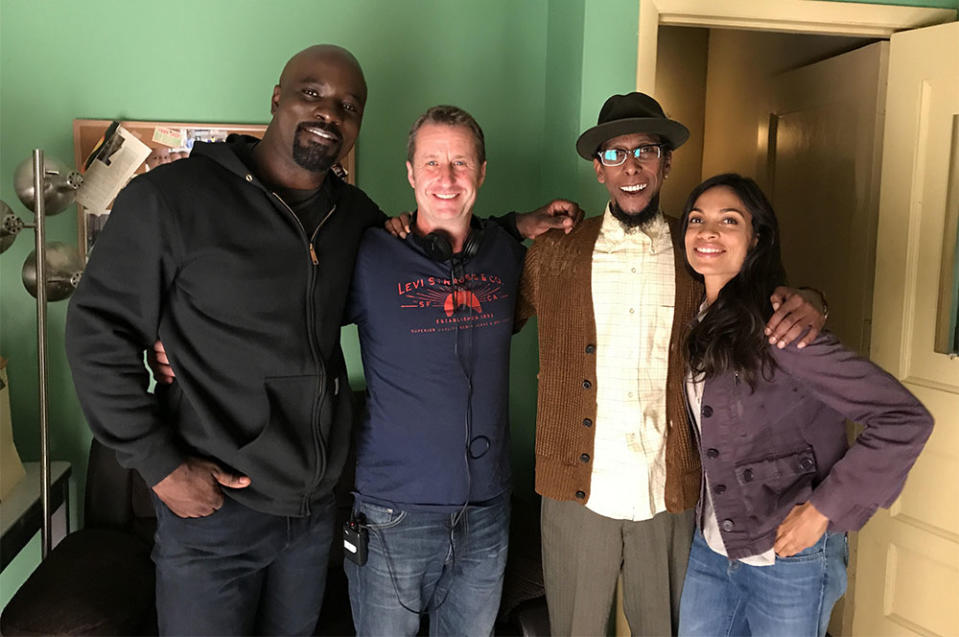
You worked with the late great Ron Cephas Jones [pictured above with Mike Colter, Rosario Dawson and Jobst] on both your Luke Cage episodes. Do you have a lasting memory from your interactions?
Yes, oh yes. This man could listen. He had no need to be loud and to prove himself and to jazz about. He just listened respectfully and humbly, and then delivered performances that, without trying, somehow had gravitas.
Given the profound impact that the 1984-85 U.K. miners’ strike had on your early days as a storyteller, do you mind sharing your perspective on the current double strike?
They are a little different. The mining communities were built up around the coal mines. Houses, schools, and shops were built to bring people specifically to work in the mines. There was nothing else, really; no other opportunities other than to “get on your bike,” as Norman Tebbit of the Tory party suggested. And that would break up family and community. When Margaret Thatcher shut the mines, she destroyed the entire landscape of living for those families that moved there and that had been born and brought up there. So the miners strike was also about survival, not just financially, but also socially, because everything was being taken away. The double strike is not only about pay and conditions, it is also about fairness. I support them totally. The creatives who generate the programs that make these companies so successful, and therefore so wealthy, must be rewarded for those skills. We need each other. We need the companies to be successful and bring our work to an audience; they need films of quality, originality and popularity to bring the audience to their platforms. Why is that so complicated? It seems like such a simple equation of shared worth, no?
***
One Piece premieres August 31 on Netflix. This interview was edited for length and clarity.
Best of The Hollywood Reporter
'Ahsoka': 15 Key Episodes From Previous 'Star Wars' Series to Watch Before the Disney+ Premiere
From 'Fuller House' to 'And Just Like That': 30 Shows That Prove TV Reboot Culture Is Alive and Well

